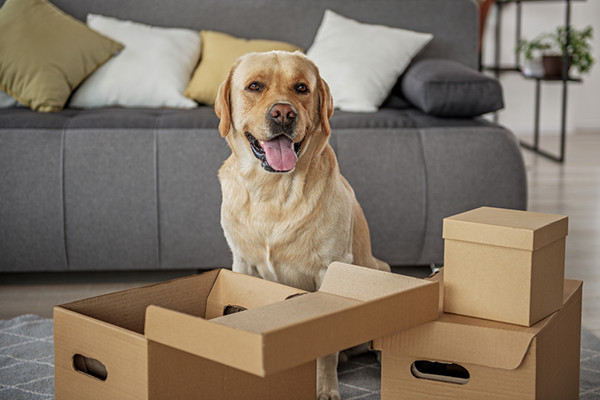

A Long-Distance Move with Your Pets
First of all, start by looking at the move from your pet's point of view. Their current home is more than their home; it's their territory. Cats, especially, are very sensitive and prefer to be in a familiar environment. Dogs tend to adjust much more easily to moves than cats. That's because new puppy owners are encouraged to socialize their puppy to get him used to new people, new smells and other dogs. So from the time they're young, dogs are out and about.
For both cats and dogs, sticking to the routine after the move is very important. Maintaining the same schedule for treats, grooming and bedtime will help your petsacclimate even more quickly. And walking your dog at the same time each day will also help him transition into his new home.
The first step in helping your new cat prepare for moving day is getting her used to a pet carrier. No matter how near - or far - you're moving, Fluffy will be safer in a pet carrier. If she's never been in a carrier, introduce the idea slowly. Start by putting a blanket and cat treats inside, leaving the door open, and making the experience a positive one.
Once she's comfortable with the carrier, the next step is familiarizing your cat with car travel. Start with short, 10-minute rides, then longer 20-minute rides. You'll find that your cat's anxiety decreases as she becomes more accustomed to sights and sounds associated with car travel. Be sure to leave the cat carrier out in the house during this time so your kitty gets used to it and even sleeps inside it whenever she chooses. While you're packing boxes, be sure to let your curious kitty sniff around and have her own fun. Just don't box her up by accident!
While you're packing, try not to isolate your dog in a dog crate. Instead, include him while you pack and move boxes, allowing him to investigate the activity. If your dog is crated or isolated in a room by himself while the rest of the family packs and prepares to move, he'll likely feel nervous which could lead to stress-related behaviors such as hyperactivity, jumping or barking.
On moving day (weather permitting), the cat carrier makes a great place for your kitty to stay in the car - ready for the drive to your new home. If it's too hot or cold, the bathroom is a great second choice. Be sure to provide her litter box, her cat carrier, food and water - and a closed door, of course.
What about your dog? One option is to assign a responsible family member to be the dedicated dog sitter (choose someone who won't be responsible for packing or moving on moving day). But it might be less stressful for your family and your dog if you have a dog-loving friend watch your dog for the day.
If your move is long-distance, your pets will need to be crate-trained well before your move. On the day of your move, your pets should be wearing collars including up-to-date rabies tags and your new address and phone number.
If you're driving, plan stops along the way to ensure you'll find pet friendly hotels. If your trip involves air travel, be sure to ask the airline about their pet travel requirements. You'll need to keep a copy of your pet's veterinarian records in your carry-on luggage.
If you've moved a long distance, now is the perfect time to ask your new neighbors to recommend a new veterinarian for your pets. Schedule a "get to know you" visit for your pets as soon as possible so you have a vet in the event of a veterinary emergency.
Just like people, every pet is unique and has a personality all their own. Because you know your pet better than anyone, you can probably predict how smoothly the transition will go. If you know that your pet is extremely skittish, talk to your veterinarian well beforehand about your concerns. He or she can recommend medication to help sedate your pet during this stressful time, if it's absolutely necessary.
The devices below will help ensure your pets’ safety while moving. They include items that will help you find your pets if they get lost, tools to keep with you while traveling, and papers for helping your pets if they get hurt.
